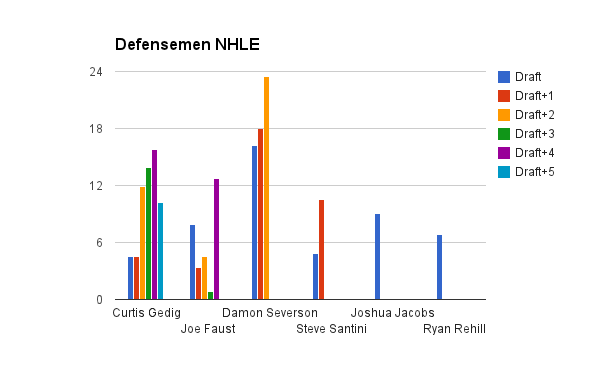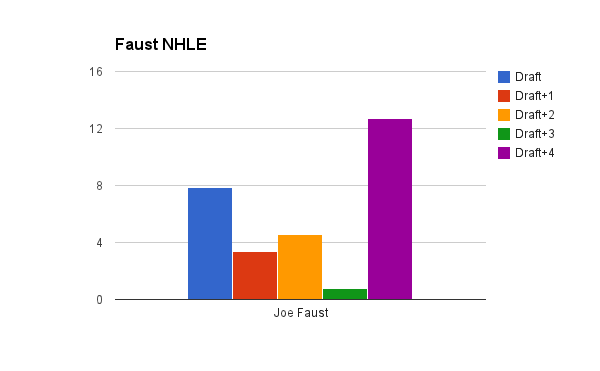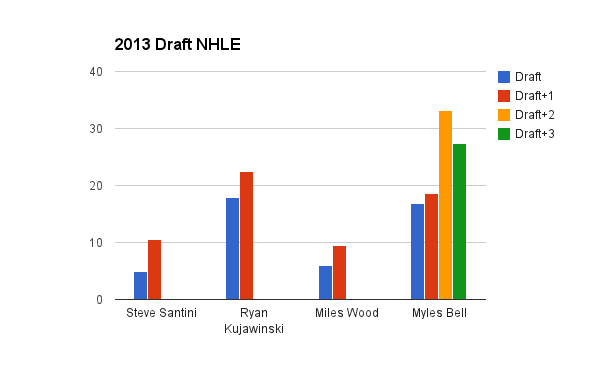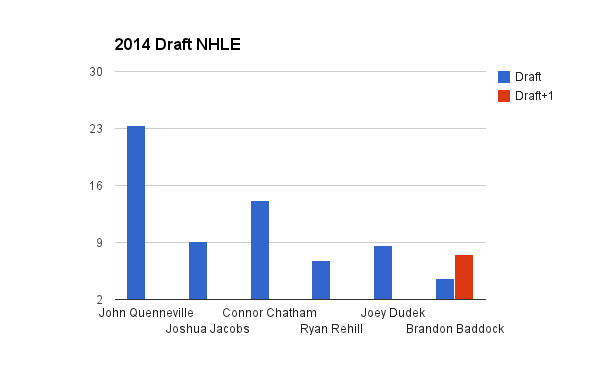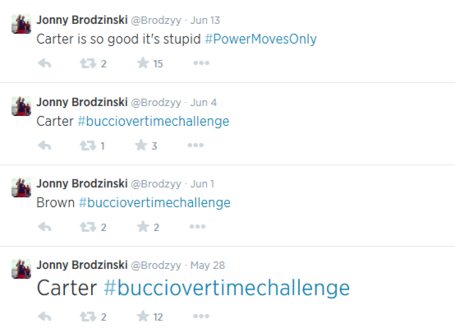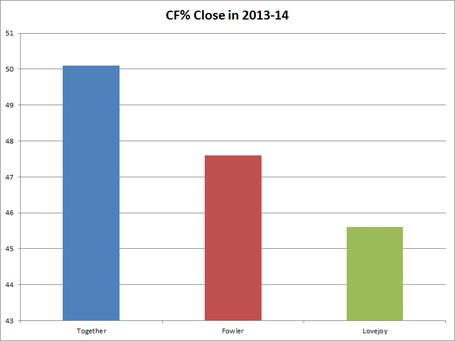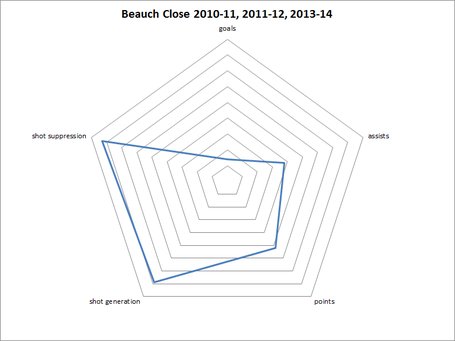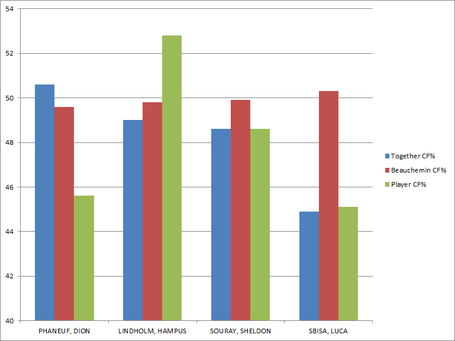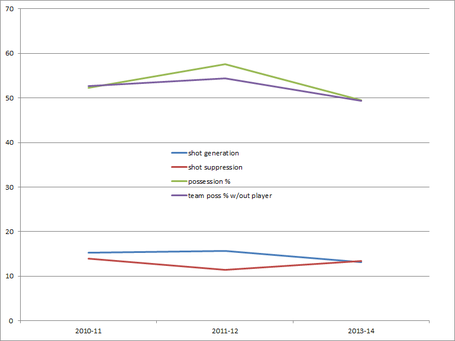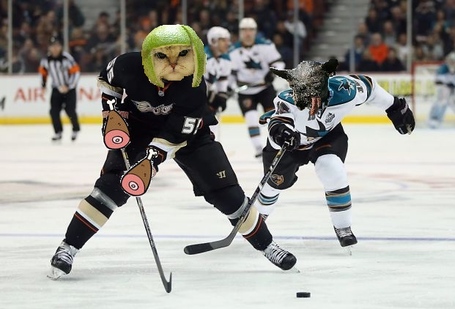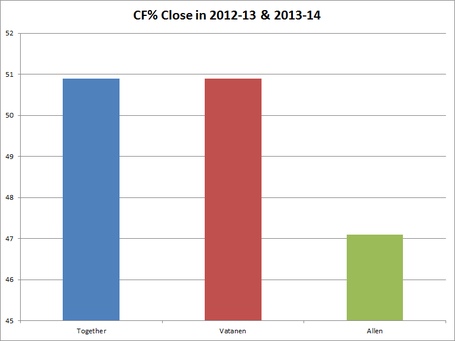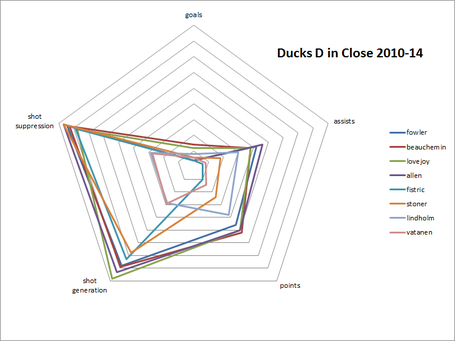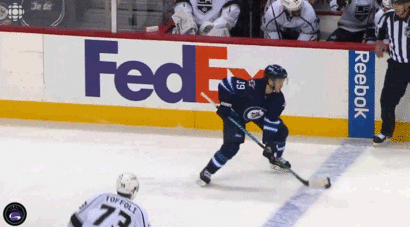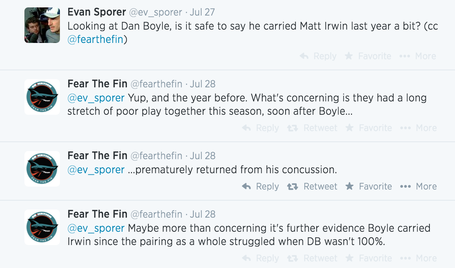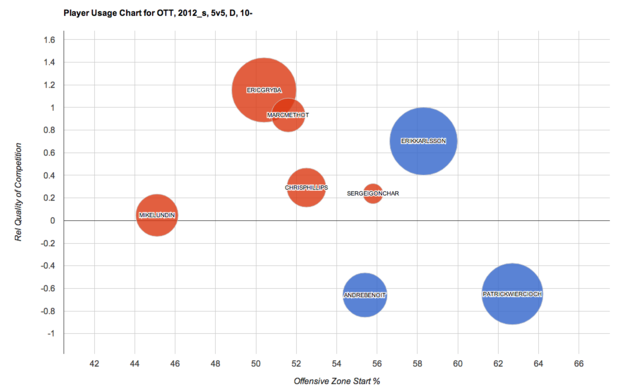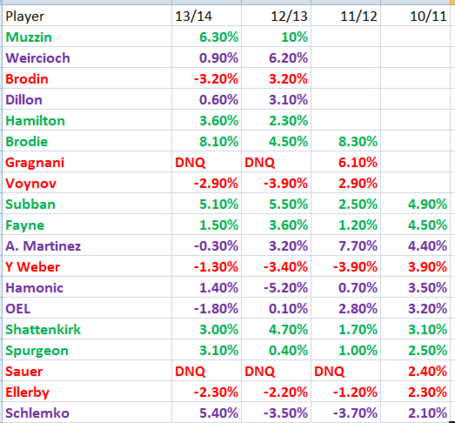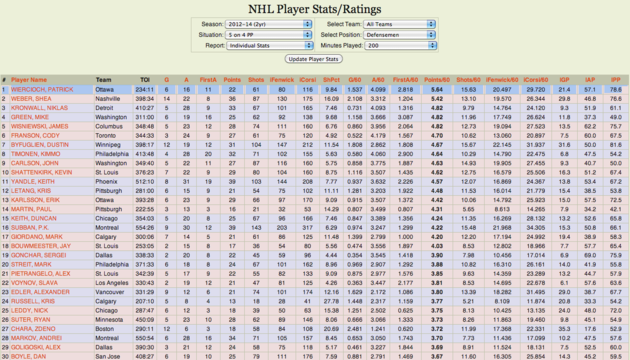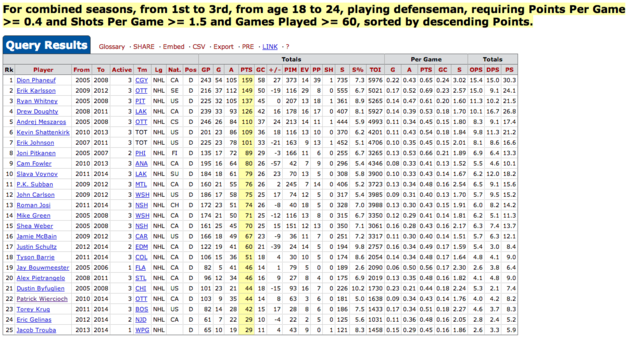![]()
This isn't even the detailed look I'd prefer (if I had the time for) doing on each player. Fun!
You guys have read my previous couple of posts on the Ducks forwards, here and here. Here's a smallish look at Dany Heatley as well here. Other than a brief examination of Stoner, I haven't really messed with the defense overall. There's a lot more I want to do when looking into this aspect, but my family and I just moved and work has picked up again, so I'll leave this bit of stuff for you guys before too much time passes.
I am using score close, zone adjusted figures exclusively here. This filters out as much of the noise of score effects and usage as possible. We're still dealing with shot-based metrics as a way of determining what each defenseman adds to the team's ability to use the puck more or less. As a general rule, defenders don't help with "suppression" as much (which might seem odd, but I can support this some other time/place if you ask!), but they can certainly contribute to "generation" in a predictive way, which means watching that suppression-generation relationship is important.
Earl Sleek, cartoonist extraordinaire at Battle of California, suggested I change the name "shot suppression" to "shots surrendered" to describe better that plot point. I agree that it makes the measurement easier to understand term-wise but it is also a bit more misleading, because the numbers really are what each player helps suppress in shots against when he's on the ice, not just the shots that are surrendered when he's out. Suppression still feels like the best term.
Cam Fowler
Here is Cam's trend chart. Again, I remove scale to make the impression of the player better. I also removed the lockout shortened season, the same way I did with the forwards last post. Same reasons, but I'll elaborate specifically in a second.
![Fowler_web_medium]()
As some of you know, I didn't like Fowler's overall game prior to last season. I didn't like his contract for what the player was, and I had become discouraged about whether his game would or could improve, especially after 2012-13. I just didn't see it, even after 2011-12 when he and Beauchemin did ok. But his play alone last year changed my mind, and it happened while he was playing with a career third pairing defenseman.
In a pure numbers sense, his best season was in 2011-12, which is when he was paired with Beauchemin. Many believe that was Frankie's influence, and maybe it was. Certainly as a pairing, they were very effective. So for reference, I've included the two's With or Without You (WOWY) numbers during that season. Clearly, Fowler drove the bus there. But they worked well together, so it was easy to assign it to the pairing and not the player.
![Fowler-beauch_wowy_medium]()
Here are his WOWYs with Lovejoy from this past season.
![Fowler-lovejoy_wowy_medium]()
Fowler is the driver of positive possession (getting the puck closer to the opposition's net) here as well, although clearly the off-chart noise dented his numbers. The first is that Fowler saw far more difficult competition in 2013-14 in a role he's never been used in, as a shutdown defenseman. The second is that he did so with Lovejoy, who never played against the level of competition or the level of minutes he did last year. Despite that, in raw terms his possession number was only one percentage point off. In simpler terms: he played more or less the same as he did in 2011-12 but against better players and with a worse partner.
Nonetheless, the trend here is what is significant: Fowler drives play more than not. He did so with Beauchemin and then again with Lovejoy. He could be a much bigger difference maker next season if paired with a better partner.
Now, a quick word: Fowler was atrocious in every capacity in 2012-13, the lockout shortened season. His main partner was Allen, but that wasn't why he was bad, because Allen was ok without him. His minutes with all other defensemen and in all game states were terrible as well. It wasn't until the playoffs when he showed improvement, which carried over into 2013-14.
This is perhaps the best example of why I try to remove that shortened season data whenever possible, because I can't explain (without access to tons of video) why he was good in 2011-12, terrible in 2012-13, and good again in 2013-14. But there is good reason to assume the lack of "sample size" in 2012-13 muddies things some. Until we see otherwise, assuming his next full season continues the progress from 2011-12 and 2013-14 isn't a terrible speculation (but is still only a guess).
I do have one theory though, with a couple facets. During the shortened season, Boudreau didn't change pairings too much. Sheldon Souray and Beauchemin played together almost exclusively, as did Fowler and Allen, both of whom are more comfortable on the same side. (Beauchemin and Lovejoy play the opposite side.) So someone will have to confirm this for me, or like I said if I had access to the Ducks copious amounts of video I'd determine it, but I think the experiment was in playing two same-sided defensemen together (one of them playing on the other side) and it didn't work out.
Francois Beauchemin
Here is Frankie's trend chart.
![Beauch_web_medium]()
Despite Beauchemin slowing down this past season, which is tied both to his age and his recovering from pretty major leg surgery, he's been a largely effective and consistent player. He's a much better even number defender, as in a better #2 paired with a #1 or a #4 with a #3. When he's put in a primary role, his play isn't as good. It doesn't surprise me then that he's really good with the younger and talented kids he's played with in Anaheim: Fowler and Lindholm.
Here's a fun chart showing some Beauchemin WOWYs with his top score close non-Fowler defensemen since 2010-11. There's all sorts of caveats to be thrown out here, especially with Sheldon Souray and poor Luca Sbisa, but this isn't really for anything but to give you another visual.
![Beauch-d_wowy_medium]()
Ben Lovejoy
Here is Lovejoy's trend chart.
![Lovejoy_web_medium]()
You will instantly think: hey this guy isn't that bad, right Kid? He's not! But he's also not a top pairing or even true second pairing defenseman. In fact, the reason his numbers are so good is because he was used appropriately until last season, when he saw a jump in his score close usage with Fowler. So in his case, I created another little chart to show you what I mean here.
![Lovejoy_line_medium]()
The top-most two lines represent his Fenwick Close percent against the team's without him on the ice. In 2010-11 and 2011-12, when he posted superior possession numbers to his team, he played third pairing minutes in score close. In 2013-14 his numbers against his team's numbers matched, a reflection of his increased minutes.
This is likewise the trend with the bottom-most lines, which are his suppression numbers in those years. He generated a lot more in light usage relative to the even generation-suppression he posted when his role increased.
Seeing something like this sort of reaffirms what I've been thinking this offseason: Lovejoy would be an ideal third pairing puck mover. He could play alongside Allen or Fistric or (shudders) Stoner and probably do well enough in limited minutes. A configuration like this would allow for the more talented Vatanen to slot in with Fowler and make unholy black magic. It certainly seems like the more prudent way to optimize the defensive depth. But that's just, like, my opinion, man.
Bryan Allen
This isn't a trend chart but is still my favorite Allen picture ever, mostly because I made it in MS Paint and think it is hilarious.
![Bryanmeollen_zpse6a7c58c_medium]()
Ok but here is his trend chart.
![Allen_web_medium]()
I have zero issue with Allen as the third pairing defenseman in score close situations. All by himself, he's a disaster. This isn't really news to anyone. But put with semi-decent talent, his numbers aren't so bad that he's completely useless. Moreover, his ability to show better with good partners makes him a decent depth player to complement those pieces. To give a good example using the Ducks younger players, here are his WOWYs from 2013-14.
![Allen-d_wowy_medium]()
That's a level of consistency that isn't a detriment to a team on the third pair. Regarding game one, round two: using him in the last minute with a lead isn't Allen's fault, it's Boudreau's fault. He's not the level of defenseman who should be put into that situation.
Mark Fistric
Here is Marky Mark's trend chart.
![Fistric_web_medium]()
In terms of his shot share control, he's more or less similar to Allen. One thing that sorta intrigues me about Fistric (versus say, Allen or Stoner) is that he's involved in fewer events on the whole than either. You might ask, "what does this mean, Kid?"
Fewer events means less shot attempts. So a low event team generally either shoots less often or suppresses shot attempts against far better. The Los Angeles Kings and New Jersey Devils are low event teams who achieve that state by primarily controlling shots against. Inversely, the Dallas Stars and Ottawa Senators were high event teams that allowed a million shots while also taking a million. The two former teams were boring, the two latter teams were exciting. BUT. Boring old low event hockey is usually less random hockey, because there's less a chance for all those events to turn into something weird.
So when I point out that a player like Fistric is involved in fewer events on either side when on the ice, I wonder why this is. I can't speak for his non-Ducks years, but my impression of his play in stints last season is that he's a decent enough defender against entries (which can lead to shot suppression) but doesn't generate anything worth a lick.
Clayton Stoner
Here's is Stoner's trend chart.
![Stoner_web_medium]()
I'm going to try to make sense of this signing.
Bzzzzzzzz bzzzzzzzz pofejgpofmbmgpdoadge,s;lf,b';,fdg;pos feoihgjrspmldfoekrmg;leksmg lkdsjgosier;gkmsadlgkmdsgdeg;lds jgslmg d;lkgmmds lk gdslk g;sl m;k;dslg,g[pepoirjg obzzzz bzbzz jgepoekgrmegf hhhm m fffffa aaaaaaaaaaaaaaaaaaaaaah.
Nope. This makes zero sense in any rational, reasonable way. No logic except "hurr hurr he's real big and hits people!" was made in considering this player.
p.s. I hate this contract and deal, in case that's not clear.
p.p.s. it sucks.
Hampus Lindholm and Sami Vatanen
These two don't have a lot of games played in their young careers, but that's why I like removing scale here. You can still see trends forming, giving us an idea of what each player has been thus far. But also remember that neither guy has played enough to have really established himself as a player before rushing to conclusions.
Let's start with Lindholm's trend chart.
![Lindholm_web_medium]()
He has a surprising amount of offense in his game in score close situations. He also played more minutes in close than he had any right to in his first season, which is pretty telling of a) the Ducks defense in general going into last season and b) his skill level. If he can build upon his rookie season, he is going to be a fantastic defenseman.
Here's his WOWYs with Beauchemin, his main partner throughout his first campaign.
![Lindholm-beauch_wowy_medium]()
Much like Fowler with Beauchemin in 2011-12, Lindholm really turned play the best of the pairing. That they couldn't break even as a pair is either due to Lindholm still learning how to ply his individual talent together on a line or Frankie being far less capable than he used to be. I figure it is a combination of both.
I could easily see Lindholm inheriting tougher minutes and being used as a shutdown defenseman. But I don't think he's ready to be the anchor on a shutdown pair yet. He will need a capable partner if he is given this role. I don't know if Beauchemin can be that partner anymore, and I fear for the team if management thought Stoner is this guy.
Teams that don't use stats (like the Ducks) still tend to overvalue "defensive defensemen." What that term really means is "guys who can't skate or pass or shoot but are big," which is what successful shutdown defenders used to be. I've written about this. If the Ducks want Stoner in that regard and aim to tie down a Lindholm (or a Vatanen) in a pair, then I don't even know. Let's hope the coaching staff is smarter than the management team here.
Here's Vatanen's trend chart.
![Vatanen_web_medium]()
In addition to limited games, Sami has only ever played limited minutes too. But what we've seen thus far is impressive. Very, very impressive. How so?
![Bndxkhwccaaoqzr_medium]()
via @DimFilipovichere
He makes nearly every player who touches the sheet of ice with him instantly better at shooting the puck on the opposing net. So that's pretty good, in my mind. A caveat to this is that the boost he gives players is likely more moderate as he plays more minutes, but as a general trend of what he's capable of bringing to the team, this is a good start.
Here are his WOWYs with Allen alone, including the shortened season (which in this case is just adding a few more games to the limited amount we have available).
![Sami-allen_wowy_medium]()
He makes Allen a +1 possession player. I think that's very good!
The thing with Sami is that he's basically going to challenge how we perceive defensemen. He's the stats debate epitomized. What I mean is that, as you can see, he's really good at turning play toward offense. But many people also remember the mistakes he makes, the turnover in the defensive end or the bad pinch that results in a breakaway the other way.
Players who have the puck all the time tend to make mistakes that are noticeable in this way, especially when they are defenders. Think P.K. Subban. Think Erik Karlsson. There's more, but you see the point. The thing about the modern game is that defense isn't just played by defensemen and offense isn't just played by forwards anymore. Those positions are basically just configurations or "where each player lines up."
Hockey is a three zone, five skater sport at this point. The guys on defense are ultimately there to help their team score more goals because they can't just obstruct forwards to prevent chances. There are no more Scott Stevens, who blew up people in the middle of the ice and slowed down the transition as a result, or even Chris Pronger, who stood at the blue line and took Shea Weber-esque hard shots at people's legs to make them move but otherwise just elbowed people who got too close him. The old methods of defense are today's penalties, so skating is the key (as it should be).
Vatanen is going to make stupid plays that stick out. He will also make unbelievable plays that stick out too. Instead of judging him by memory, judging him by what he's bringing to the team in terms of "offense" is better. He's positively impacting the Ducks ability to attempt to score, which is the best thing. The mistakes we see are the normal mistakes a super young player who is learning the game still makes.
If he can take the positive shot differential trend along with him as his minutes jump, he will be the team's best defensemen without question. I mean that very literally. But that's if he can carry his level of play into more roles and that the coaching staff doesn't pair him with Stoner all year. (Although he could be good enough to make Stoner passable, who knows.)
Here's the pretty-pretty with everyone.
![D_web_medium]()


